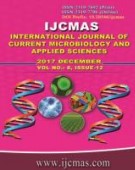


 National Academy of Agricultural Sciences (NAAS)
National Academy of Agricultural Sciences (NAAS)

|
PRINT ISSN : 2319-7692
Online ISSN : 2319-7706 Issues : 12 per year Publisher : Excellent Publishers Email : editorijcmas@gmail.com / submit@ijcmas.com Editor-in-chief: Dr.M.Prakash Index Copernicus ICV 2018: 95.39 NAAS RATING 2020: 5.38 |
The valuable information through the Non-hierarchical Euclidean cluster analysis including one hundred four genotypes, were grouped in to eleven clusters, indicating the existence of high degree of genetic diversity in the germplasm collections evaluated under sodic soil (pH=9.2; EC=2.21 of dSm-1; ESP=45%). Analysis of variance revealed highly significant differences among germplasm collections indicating wide genetic variability in the existing genetic stock. The eleven clusters formed in divergence analysis contained genotypes of heterogeneous origin, thereby indicating non-parallelism between genetic and geographic diversity. In this context, cluster X, having single entry Kalanamak-Nitch, had very high inter-cluster distances from cluster III, IV, II, IX, VII and I. In addition, very high inter-cluster distances were also shown by cluster IX from cluster III, VII and VI, while cluster VIII exhibited high inter cluster distances from cluster III, II and I. The different clusters showed considerable differences in intra-cluster group means of eleven clusters and genotypes having distinctly different mean performance for various characters, were separated into different clusters. The lines belonging to diverse clusters and showing high mean performance in desirable direction for different traits, may be choosen as parents. In this context, the most promising genotypes for use as parents in hybridization programme were IR 26, Jagriti and Mehak of cluster I, NDRK 5095 and Pusa 33A of cluster II; NDRK 50039 and NDRK 50035 of cluster III and NDRK 50028, NDRK 50027, NDRK 50025 and IR-76346-3B-10-1-1-1 of cluster IV. Narendra Usar Dhan 3, NDRK 50034, Narendra Usar 2004 and Sarjoo 52 of cluster V; IR-72579-R-2R-1-3, Basmati Chandauli, Multan Basmati, Basmati Dehradoon, Kapoor Chinni and Dubraj Mirjapur of cluster VI; NDRK 5014, NDRK 5040, Sundri, Sugandhamati and NDRK 50030 of cluster VII and CSR 43, AGAMI-MI, NDRK 50032 and Johar of cluster VIII emerged as lines to be recommended for exploitation in hybridization programme to enhance the production and productivity of sodic soil.
 |
 |
 |
 |
 |